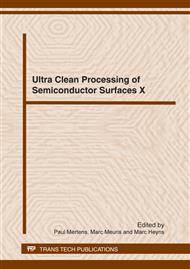p.141
p.145
p.149
p.153
p.159
p.163
p.167
p.171
p.177
Comparison of Gold Particle Removal from Fused Silica and Thermal Oxide Surfaces in Dilute Ammonium Hydroxide Solutions
Abstract:
Removal of gold particles (40 nm and 100 nm) from fused silica and thermal oxide surfaces in dilute ammonium hydroxide solutions has been investigated. The particle removal efficiency (PRE) from fused silica surface has been found to be a strong function of ammonium hydroxide concentration and bath temperature. PRE increases from 0 to 85 % with increase in bath temperature from 30 to 80 °C for ammonium hydroxide concentration of 1 %. Addition of megasonic energy to the ammonium hydroxide bath at 30 °C has also shown to improve the PRE significantly. In the case of thermal oxide, the removal of gold particles is much easier compared to that from fused silica. Even for cleaning at 30 °C, the PRE for oxide surface increases from 10 to 90 % with increase in ammonium hydroxide concentration from 0 % to 4 %. Atomic force microscopy measurements reveal that an adhesion force of 10 mN/m exists between fused silica and gold particles in 4 % ammonium hydroxide solution as opposed to only repulsive force in the case of thermal oxide.
Info:
Periodical:
Pages:
159-162
Citation:
Online since:
April 2012
Authors:
Price:
Сopyright:
© 2012 Trans Tech Publications Ltd. All Rights Reserved
Share:
Citation:


